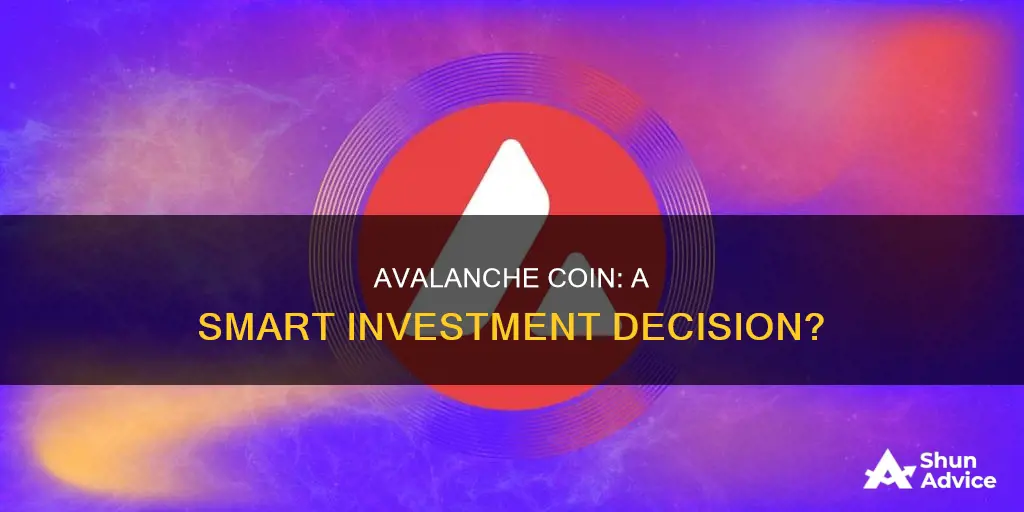
Avalanche (AVAX) is a cryptocurrency and blockchain platform that rivals Ethereum. Launched in 2020, it aims to be fast, versatile, secure, affordable, and accessible. In this paragraph, we will explore whether Avalanche coin is a good investment. We will look at its performance, potential risks, and what experts are saying about its future.
What You'll Learn

Avalanche's scalability and transaction speed
Avalanche is a blockchain platform and cryptocurrency that aims to provide a fast, scalable, and decentralized network for building custom decentralized applications. It is a direct competitor to Ethereum and is known for its speed and scalability.
Avalanche's unique consensus algorithm, the Avalanche consensus, enables fast consensus and high throughput. It relies on a voting-based system that enables nodes to reach an agreement on the status of transactions and the validity of the network. This mechanism ensures the efficient and secure operation of the Avalanche network.
The platform's ability to process a large number of transactions quickly is one of its key advantages. It can handle up to 4,500 transactions per second, offering lightning-fast confirmation and settlement of transactions. This high transaction speed makes Avalanche suitable for various applications, including decentralized finance (DeFi), non-fungible tokens (NFTs), gaming, and supply chain management.
The scalability of the Avalanche network is further enhanced by its use of subnets. Subnets are Avalanche's form of horizontal scaling, similar to sharding. They create independent but connected instances of the same chain, allowing for multiple blockchains to be executed in parallel. This enables unlimited throughput gains, making Avalanche extremely fast and scalable while maintaining security and decentralization.
The combination of its innovative consensus mechanism and subnet functionality has allowed Avalanche to become one of the fastest blockchain networks. Transactions are typically finalized in under a second, outperforming its competitors.
In addition to its speed and scalability, Avalanche also offers lower transaction fees compared to platforms like Ethereum. The average transaction cost on AVAX is approximately 50 cents, while Ethereum's average fee is $0.67. This makes Avalanche a more affordable option for users.
Overall, Avalanche's scalability and transaction speed are among its most notable features, making it a compelling choice for blockchain enthusiasts and developers seeking a fast, efficient, and scalable platform for their applications.
The Ultimate Guide to Investing in Bitcoin
You may want to see also

Avalanche vs. Ethereum
Avalanche (AVAX) and Ethereum (ETH) are two of the most popular cryptocurrencies in the market today. Both platforms offer unique features and benefits, but there are some key differences between the two. Here is a detailed comparison of Avalanche vs. Ethereum:
Overview
Avalanche is a decentralized platform that enables developers to create and deploy decentralized applications (dApps). It was launched in 2020 and has gained attention for its high-speed, low-cost transactions. Avalanche is composed of three blockchain networks: the Exchange Chain (X-Chain), the Contract Chain (C-Chain), and the Platform Chain (P-Chain). The platform aims to be fast, versatile, secure, affordable, and accessible.
Ethereum, on the other hand, is the most popular blockchain platform for building decentralized applications and smart contracts. It was launched in 2015 and has a vast ecosystem of developers and users. Ethereum is a smart contract-focused blockchain and sits at the top of the decentralized finance (DeFi) food chain. However, it has faced some issues with slow transactions and steep fees.
Transaction Speed
Transaction speed is a crucial factor in the cryptocurrency world, especially for developers building dApps. Avalanche has a significant advantage over Ethereum in this area, as it can process up to 4,500 transactions per second (TPS), while Ethereum is limited to 15 TPS. This makes Avalanche a more attractive platform for building high-performance dApps that require fast and efficient transactions.
Scalability
Scalability is another important consideration when choosing a blockchain platform. Ethereum has faced scalability issues due to its limited capacity to process transactions, resulting in high gas fees and slower transaction times. Avalanche, on the other hand, has a unique architecture that allows it to scale its network according to demand, making it more suitable for building scalable dApps. Avalanche's multi-chain design gives it incredible linear scalability, and it can process up to 6,500 transactions per second, with the potential to handle millions.
Tokens
Avalanche's native token is AVAX, which is used to pay for transactions, secure the network, and act as a basic unit of account among blockchains in the Avalanche network. AVAX has a total supply capped at 720 million tokens, and transaction fees are burned to increase scarcity over time.
Ethereum's native token is Ether (ETH), which is one of the most famous tokens and is listed on almost all crypto exchanges. It is used to pay validators, participate in ICOs, and more.
DeFi Features
Both Avalanche and Ethereum are used in the DeFi space, with Ethereum currently having a larger application ecosystem. However, Avalanche is catching up and offers all the same features as Ethereum, including staking, lending, and farming. Users are paid in AVAX, which they can stake back to increase their returns.
Final Verdict
When it comes to scalability and fees, Avalanche is the clear winner. However, in terms of usage in the DeFi space and security, Ethereum takes the lead. Ethereum has a vast ecosystem, battle-tested security, and an established reputation, making it a more reliable platform for developers building complex decentralized applications. Ultimately, the choice between Avalanche and Ethereum depends on your specific needs and requirements.
Ally Invest: Buying Bitcoin, Explained
You may want to see also

AVAX's growth factors
Avalanche (AVAX) is a cryptocurrency and blockchain platform that rivals Ethereum. It was launched in 2020 and is a competitor to Ethereum, prioritising scalability and transaction processing speed. Here are some of the key growth factors for AVAX:
Scalability
The Avalanche network uses subnets to boost transaction throughput, claiming to handle 6,500 transactions per second (TPS). This is significantly higher than Ethereum's 15 TPS and gives Avalanche a long-term advantage over its competitor. The scalability of the Avalanche network is a critical factor in AVAX's growth.
Transaction Speed
One of the key selling points of Avalanche is its fast transaction processing times. Its consensus protocol enables the network to validate transactions much faster than Ethereum. This is a significant advantage in the world of decentralised finance, where quick confirmation times are essential.
Security
Avalanche can be considered secure due to the randomised nature of its consensus mechanism. Its platform supports stronger safety measures that make the blockchain less vulnerable to 51% attacks than other blockchains.
Eco-Friendliness
Unlike Proof-of-Work (PoW) cryptocurrencies that consume substantial energy, Avalanche's consensus mechanism is more energy-efficient. This aligns with growing concerns about the environmental impact of blockchain technologies and could attract more environmentally conscious investors.
Staking Rewards
AVAX holders can earn staking rewards by participating in the network's proof-of-stake consensus mechanism. This provides an incentive for users to hold and stake their AVAX tokens, potentially increasing their value over time.
Smart Contract Functionality
As a Layer 1 network, Avalanche seeks to rival Ethereum in smart contract functionality. Its compatibility with Ethereum Virtual Machine (EVM) and the programming language Solidity have made it a popular network for developers. This could lead to increased adoption and usage of the Avalanche platform.
Low Fees
The average transaction cost on AVAX is approximately 50 cents, compared to Ethereum's $0.67. This makes Avalanche a more affordable option for users, especially for those looking to execute multiple transactions.
Decentralised Applications (dApps)
Avalanche's smart contracts platform supports decentralised applications. This enables developers to create a range of blockchain-based projects, from decentralised finance (DeFi) applications to gaming platforms.
Autonomous Blockchains
In addition to dApps, Avalanche also supports autonomous blockchains. This gives developers the flexibility to create custom blockchain environments tailored to specific needs.
Interoperability
AVAX is designed with interoperability in mind, allowing its network to connect with other blockchain networks. This promotes seamless asset transfer and communication between different platforms, increasing the potential for widespread adoption.
Growing Adoption
Avalanche has attracted several high-profile projects and collaborations, contributing to its growing ecosystem. Its ongoing developments, such as upgrades and new features, could further enhance its functionality and appeal.
Positive Price Predictions
Industry experts and analysts predict a bullish trend for AVAX in the future. For example, AMBCrypto believes that AVAX could reach $3,056.83 by 2030, while Changelly predicts a price of $225.20 by the same year. These predictions, along with its strong market position and high network performance, make AVAX a coin to watch in the upcoming cycle.
Best Crypto Coins: Where to Invest Your Money?
You may want to see also

Avalanche's security and sustainability
Avalanche (AVAX) is a blockchain platform and cryptocurrency that rivals Ethereum. It was launched in 2020 by Ava Labs and is an open-source project, meaning anyone can view and contribute to the platform's code.
Avalanche's security is based on its proof-of-stake consensus mechanism. This requires blockchain validators to put up a stake, such as the chain's native cryptocurrency, in order to participate. A validator is then randomly selected to affirm the integrity of a transaction. Once this is done, the block is added to the chain and the validator is rewarded. This protocol disincentivizes fraudulent activity, as any threat actor who falsifies a block will lose their investment.
Avalanche's proof-of-stake protocol also provides a high degree of resistance against 51% attacks. For a threat actor to control the majority of the stake in a proof-of-stake context, they would need to invest a prohibitively large amount, and they would risk losing their entire stake.
Avalanche also claims that its platform supports stronger safety measures that make it less vulnerable to 51% attacks than other blockchains. However, it is important to note that blockchains with fewer network participants are more susceptible to attacks.
In terms of sustainability, Avalanche is at the forefront of the crypto sustainability revolution. The platform has successfully implemented and demonstrated the viability of several important energy-efficient innovations. According to the Crypto Carbon Ratings Institute, Avalanche consumes the same amount of energy as only 46 US households each year. This is in stark contrast to traditional crypto transactions, which use proof-of-work and require a colossal amount of electricity.
Ava Labs, the creator of Avalanche, has also established other sustainability initiatives. These include a novel consensus protocol that requires no energy-intensive mining, as well as a commitment to plastic-free live events.
Strategic Bitcoin Investments: How Much to Invest?
You may want to see also

Avalanche's price predictions
Avalanche (AVAX) is a cryptocurrency and blockchain platform that rivals Ethereum. Launched in 2020, it aims to be fast, versatile, secure, affordable, and accessible.
AVAX is the native token of the Avalanche blockchain, which uses smart contracts to support various blockchain projects. It is used to pay transaction processing fees, secure the Avalanche network, and act as a basic unit of account among blockchains in the Avalanche network.
2024
According to Changelly, AVAX could trade between $20.51 and $45.15 in 2024. CoinPedia has a more positive outlook, predicting AVAX to hit as high as $100. The consensus among analysts is that AVAX will trade, on average, around $52.01 in 2024, representing a 129% growth from current prices. Cryptopolitan predicts that AVAX will trade between $20.00 and $30.54, with an average price of $20.84.
2025
Changelly, CoinPedia, and BitScreener predict that AVAX will trade around $79.33 in 2025. Cryptopolitan's prediction for 2025 is a high of $46.60, with a minimum price of $37.73 and an average price of $39.11.
2026
Cryptopolitan predicts that AVAX will cross the $50 mark in 2026, with a price range of $55.99 to $65.79 and an average price of $57.94.
2027
Cryptopolitan's prediction for 2027 is a price range of $82.69 to $98.68, with an average price of $85.01.
2028
Cryptopolitan predicts that AVAX will reach $100 in 2028, with a maximum price of $144.43.
2029
According to Cryptopolitan, the price of AVAX in 2029 will range from a minimum of $177.84 to a maximum of $212.32, with an average of $182.98.
2030
Changelly predicts that AVAX will trade around $225.20 in 2030. CoinCodex predicts a less bullish price, with AVAX trading between $57.04 and $92.48. Cryptopolitan's prediction for 2030 is a price range of $244.11 to $310.02, with an average of $253.26.
It is important to note that cryptocurrency is a highly volatile asset class, and price predictions are subject to change. Investors should always do their research and carefully consider the risks before investing.
Best Platforms for Bitcoin Investment
You may want to see also
Frequently asked questions
Avalanche is a cryptocurrency and blockchain platform that rivals Ethereum. It was launched in 2020 and has been a popular network for developers to build on.
AVAX is the native token of the Avalanche blockchain. It is used to pay transaction processing fees, secure the Avalanche network, and act as a basic unit of account among blockchains in the Avalanche network.
Avalanche has fast transaction processing times, a reward structure that incentivizes participation, and the capability to support many blockchain-based projects.
Avalanche (AVAX) shows promising potential as an investment. With its innovative decentralized finance (DeFi) approach, positive AVAX future price expectations, and strong market position, it is considered a good investment by many analysts. However, it is important to remember that cryptocurrency is a risky asset class, and investors should only invest what they can afford to lose.







